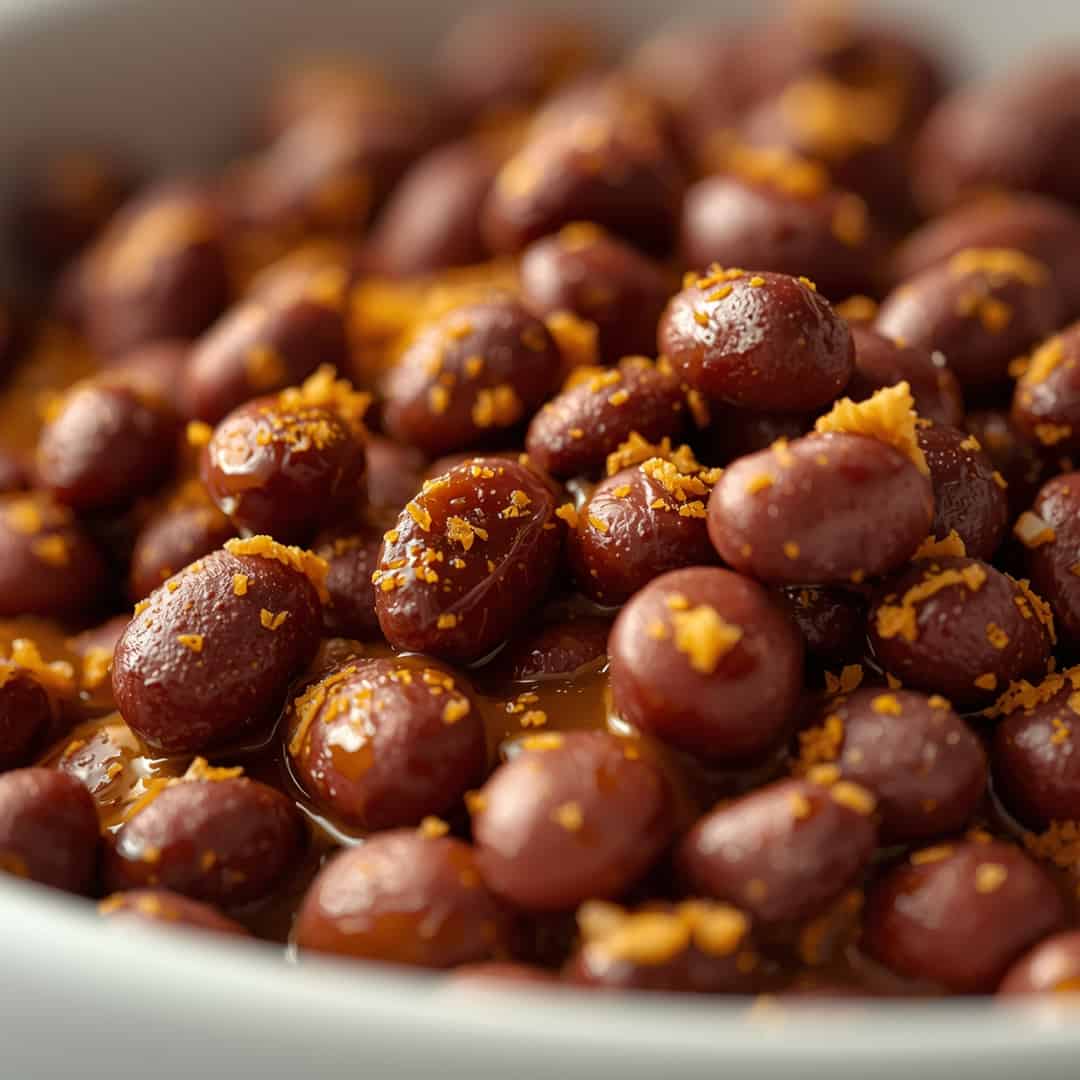Pressure Canned Black Beans are a pantry staple that can transform your weeknight meals, and this simple recipe guides you through the process of canning them yourself for incredible savings and unparalleled freshness anytime. Mastering how to pressure can black beans means always having a healthy, delicious, and ready-to-use ingredient for soups, salads, tacos, and so much more.
Key Ingredients for Pressure Canned Black Beans :
- Dried Black Beans: 2 pounds (about 4 cups)
- Water: For soaking and processing
- Salt (optional): 1 teaspoon per pint jar, or 2 teaspoons per quart jar
How to Make Pressure Canned Black Beans :
This easy method for preparing pressure can black beans is designed for maximum flavor and convenience, promising a satisfying meal starter every time. With creamy textures and a rich, earthy taste, these beans are far superior to store-bought alternatives. Preparation takes about 15 minutes of active time, plus soaking and pressure canning time.
Step-by-Step Instructions :
- Sort and Rinse Beans: Carefully inspect the dried black beans for any small stones, debris, or discolored beans. Discard any you find. Place the sorted beans in a colander and rinse them thoroughly under cool running water.
- Soak Beans: There are two common methods for soaking beans, both effective for pressure can black beans.
- Overnight Soak: Place the rinsed beans in a large pot and cover them with about 2 inches of water. Let them soak at room temperature for 8-12 hours, or overnight. The beans will roughly double in size.
- Quick Soak: Place the rinsed beans in a large pot and cover with about 2 inches of water. Bring the water to a boil and let it boil for 1-3 minutes. Remove from heat, cover, and let stand for 1 hour.
- Drain and Rinse Soaked Beans: After soaking, drain the water from the beans and rinse them again under cool running water.
- Pre-cook Beans (Optional but Recommended for Texture): For the best flavor and texture when you pressure can black beans, it’s recommended to pre-cook them. Place the soaked and drained beans in a large pot. Cover with fresh water, ensuring the water level is about 2 inches above the beans. Bring to a boil, then reduce heat and simmer for 30 minutes, or until the beans are tender but not mushy. Drain the beans from the cooking water.
- Prepare Jars and Lids: Wash your canning jars, lids, and bands in hot, soapy water. Rinse thoroughly. Keep the jars hot (you can place them in a warming oven set to 200°F or fill them with hot water) to prevent them from breaking when filled with hot beans. Prepare the lids according to the manufacturer’s instructions.
- Pack Jars: Loosely pack the pre-cooked (or simply soaked, if skipping pre-cooking) black beans into your hot canning jars. Fill the jars, leaving a 1-inch headspace between the top of the beans and the rim of the jar.
- Add Liquid: Cover the beans with boiling water, maintaining the 1-inch headspace. If you are adding salt, add your desired amount now (1 teaspoon per pint, 2 teaspoons per quart).
- Remove Air Bubbles: Gently slide a non-metallic spatula or plastic knife around the inside of the jar to release any trapped air bubbles. Add more boiling water if needed to maintain the 1-inch headspace.
- Wipe Jar Rims: Carefully wipe the rims of each jar with a clean, damp cloth to ensure a good seal.
- Place Lids and Bands: Center the flat lid on each jar and screw on the band until it is fingertip-tight. Do not overtighten.
- Prepare Pressure Canner: Add the amount of water to your pressure canner as specified in the manufacturer’s instructions. For most canners, this is 2-3 inches of water. Place the filled jars on the rack in the canner, ensuring they do not touch each other.
- Process Jars: Lock the lid onto the pressure canner. Vent the canner according to the manufacturer’s instructions (usually for 10 minutes). Once steam is venting steadily, bring the canner up to the required pressure for your altitude (e.g., 15 psi for weighted gauge, or 11 psi for dial gauge at sea level).
- Processing Time: Process pints for 75 minutes and quarts for 90 minutes.
- Cool Down and Check Seals: Once the processing time is complete, turn off the heat. Allow the pressure to drop to zero naturally. Do not force cool the canner. Carefully remove the canner lid away from your face. Let the jars sit in the canner for another 10 minutes before removing them.
- Remove and Inspect Jars: Carefully lift the jars from the canner using a jar lifter and place them on a towel-lined counter or cooling rack. Leave at least 1 inch of space between jars. Let them cool undisturbed for 12-24 hours. After cooling, check that the lids have sealed. The center of the lid should be concave (curved inward) and should not flex up and down when pressed. Remove the bands from any sealed jars, wipe them clean, and store the jars without the bands to prevent rust and to more easily spot a broken seal later.
Why You’ll Love This Pressure Canned Black Beans :
You’ll absolutely adore having perfectly cooked pressure can black beans ready at a moment’s notice, transforming ho-hum meals into vibrant, delicious creations. Unlike the often-mushy texture of some canned varieties, these beans retain a delightful bite and a rich, earthy flavor that makes them a standout ingredient. Imagine the cost savings compared to buying canned beans regularly – this investment in your pantry pays for itself many times over, offering a healthy and budget-friendly choice for your family’s meals.
These versatile beans are a secret weapon for busy cooks, providing a foundation for everything from hearty chilis and zesty dips to quick and healthy side dishes. Think about how much easier and more economical it is to prepare a vibrant black bean salad or a satisfying Cuban black bean soup from your own meticulously prepared pantry staples. So, gather your supplies and give this foolproof method for pressure can black beans a try; your future self, and your taste buds, will certainly thank you!
Storing and Reheating Tips :
Proper storage of your pressure can black beans is crucial for maintaining their quality and safety.
- Refrigeration: Sealed jars of pressure-canned black beans can be stored in a cool, dark place for up to 12-18 months for optimal flavor. Once a jar is opened, store any leftovers in an airtight container in the refrigerator and consume within 3-4 days.
- Freezing (Unopened Jars): While not the primary method for pressure-canned goods, if you have any concerns about a questionable seal, you can freeze the opened beans in freezer-safe containers for future use. However, your goal with pressure canning is shelf-stability.
- Checking Seals: Before consuming, always check that the lid is still sealed (center is concave and does not flex). If a lid has popped or appears damaged, do not consume the contents. Discard any unsealed jars.
- Reheating (from a sealed jar): You can use the beans directly from the jar in most recipes. If you prefer them warm, drain and rinse them, then briefly heat them in a saucepan with a little water or broth, or add them directly into your simmering dish.
Final Thoughts :
Mastering how to pressure can black beans is a rewarding culinary skill that offers both convenience and significant cost savings. Empower yourself to enjoy exceptionally fresh, healthy, and delicious black beans year-round by trying this simple and effective canning method today.
Read more :
- Canning Corn on the Cob
- Canning Vegetable Soup
- Pickled Mixed Vegetables (Giardiniera)
- Canning Vegetable Stock
- Pressure Canning Green Beans
- our Pinterest

Pressure Canned Black Beans
Ingredients
Equipment
Method
- Carefully inspect the dried black beans for any small stones, debris, or discolored beans. Discard any you find. Place the sorted beans in a colander and rinse them thoroughly under cool running water.2 pounds Dried Black Beans
- Overnight Soak: Place the rinsed beans in a large pot and cover them with about 2 inches of water. Let them soak at room temperature for 8-12 hours, or overnight. The beans will roughly double in size.2 pounds Dried Black Beans, Water
- Quick Soak: Place the rinsed beans in a large pot and cover with about 2 inches of water. Bring the water to a boil and let it boil for 1-3 minutes. Remove from heat, cover, and let stand for 1 hour.2 pounds Dried Black Beans, Water
- After soaking, drain the water from the beans and rinse them again under cool running water.2 pounds Dried Black Beans, Water
- Place the soaked and drained beans in a large pot. Cover with fresh water, ensuring the water level is about 2 inches above the beans. Bring to a boil, then reduce heat and simmer for 30 minutes, or until the beans are tender but not mushy. Drain the beans from the cooking water.2 pounds Dried Black Beans, Water
- Wash your canning jars, lids, and bands in hot, soapy water. Rinse thoroughly. Keep the jars hot (you can place them in a warming oven set to 200°F or fill them with hot water) to prevent them from breaking when filled with hot beans. Prepare the lids according to the manufacturer’s instructions.
- Loosely pack the pre-cooked (or simply soaked, if skipping pre-cooking) black beans into your hot canning jars. Fill the jars, leaving a 1-inch headspace between the top of the beans and the rim of the jar.2 pounds Dried Black Beans
- Cover the beans with boiling water, maintaining the 1-inch headspace. If you are adding salt, add your desired amount now (1 teaspoon per pint, 2 teaspoons per quart).Water, 1 teaspoon Salt
- Gently slide a non-metallic spatula or plastic knife around the inside of the jar to release any trapped air bubbles. Add more boiling water if needed to maintain the 1-inch headspace.Water
- Carefully wipe the rims of each jar with a clean, damp cloth to ensure a good seal.
- Center the flat lid on each jar and screw on the band until it is fingertip-tight. Do not overtighten.
- Add the amount of water to your pressure canner as specified in the manufacturer’s instructions. For most canners, this is 2-3 inches of water. Place the filled jars on the rack in the canner, ensuring they do not touch each other.Water
- Lock the lid onto the pressure canner. Vent the canner according to the manufacturer’s instructions (usually for 10 minutes). Once steam is venting steadily, bring the canner up to the required pressure for your altitude (e.g., 15 psi for weighted gauge, or 11 psi for dial gauge at sea level).
- Process pints for 75 minutes and quarts for 90 minutes.
- Once the processing time is complete, turn off the heat. Allow the pressure to drop to zero naturally. Do not force cool the canner. Carefully remove the canner lid away from your face. Let the jars sit in the canner for another 10 minutes before removing them.
- Carefully lift the jars from the canner using a jar lifter and place them on a towel-lined counter or cooling rack. Leave at least 1 inch of space between jars. Let them cool undisturbed for 12-24 hours. After cooling, check that the lids have sealed. The center of the lid should be concave (curved inward) and should not flex up and down when pressed. Remove the bands from any sealed jars, wipe them clean, and store the jars without the bands to prevent rust and to more easily spot a broken seal later.
